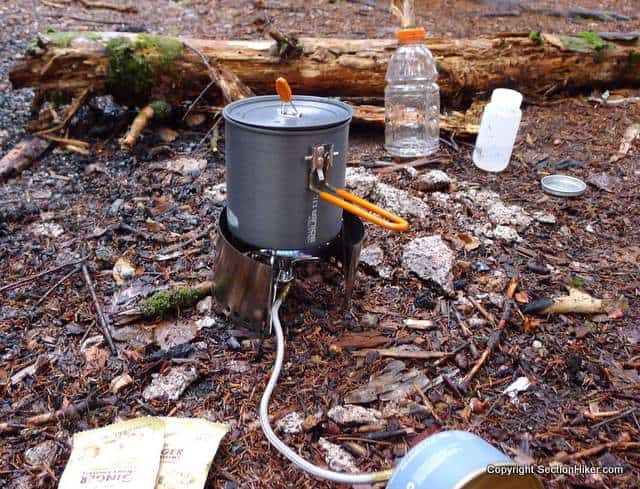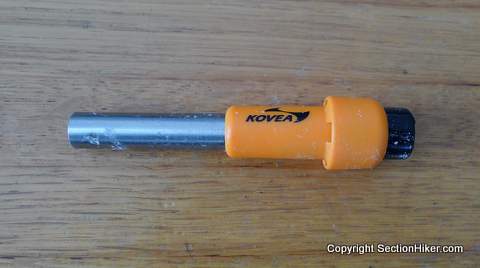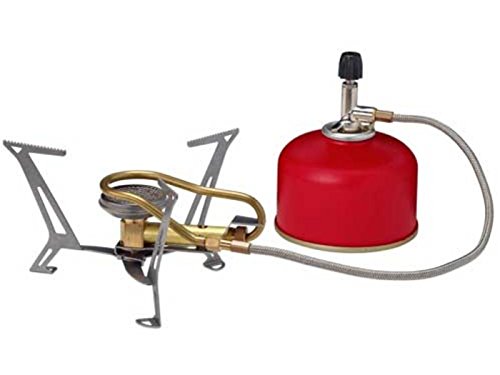 The Kovea Spider Inverted Canister Stove is a four-season backpacking and camping stove that has many advantages over fully integrated and component canister stove systems. Chief amongst these is the fact that it can burn canister fuel in liquid form, with the canister turned upside down, so it can be used in colder temperatures than canister stoves that can only burn canister fuel in its gaseous form.
The Kovea Spider Inverted Canister Stove is a four-season backpacking and camping stove that has many advantages over fully integrated and component canister stove systems. Chief amongst these is the fact that it can burn canister fuel in liquid form, with the canister turned upside down, so it can be used in colder temperatures than canister stoves that can only burn canister fuel in its gaseous form.
Kovea Spider Inverted Canister Backpacking Stove
Fuel Efficiency
Weight
Simmering Ability
Time to Boil
Ease of Use
Excellent
First and foremost, the Kovea Spider can be used with different pots of all shapes and sizes, making it convenient for group camping as well as solo backpacking trips. The stove has an integrated locking pot stand, set very low to the ground, which provides excellent stability for tall skinny pots and squat wide ones. I’ve cooked everything from multi-person meals to one-pot ramen dinners using this stove and if you only want to buy one canister stove for car camping and backpacking, it’s a best buy.

Second, the Kovea Spider, like other remote canister stoves, can be used with a windscreen to improve stove efficiency. This is unsafe when using a stove burner that screws directly into the threaded connector on top of an isobutane canister because the canister can overheat and explode like a grenade. Using a stove screen is particularly important in winter when melting snow for drinking water because you want all the heat to hit the bottom of the pot and not be lost up the pot’s sides.

Finally, the Kovea Spider can operate at colder temperatures than regular canister stoves because the canister can be turned update down or inverted when outside temperatures drop below 15 degrees Fahrenheit and the pressure inside an isobutane canister drops too low to vaporize.
By inverting the canister, the Kovea Spider can burn the fuel inside the canister in its liquid form down to about 0 degrees Fahrenheit, giving you a 10-15 degree advantage over regular canister stoves that can only burn isobutane in its vapor form.

When you turn a gas canister upside down, the canister fuel flows down the Spider’s fuel hose to the burner where it’s preheated before reaching the burner head. The Spider has a bronze-colored tube, which you can see in the photo above, which raises the temperature of the fuel so it can vaporize just like it would if the air temperature was warmer and the canister was positioned right side up.

If there’s a downside to running the Kovea Spider in inverted canister mode, it’s that the flow of fuel becomes a little harder to control and more like a regular liquid fuel (white gas) stove. For example, when you turn off the fuel valve, the fuel in the line has to burn off completely before the flame goes out. The same holds during ignition, when you can experience a bit of a fireball when lighting the stove.

The Kovea Spider does not have an integrated piezo lighter, unlike many regular canister stoves, where the burner is mated with the canister. Instead, the stove comes with an easy-to-lose, push-button piezo wand. While the peizo works great in warmer temperatures when burning your fuel as vapor, it stops working in cold temperatures (which piezos are known to do) when you’re likely to use the stove in inverted canister mode. For colder weather, you’ll want to bring an ignition source that will throw a bigger spark or flame, like a fire steel or matches.

One of the nice features of the Kovea Spider, beyond its utility in hot and cold temperatures, is the packability of the stove, which can fit in a one liter cooking pot with a large fuel canister. If you’ve ever tried to pack a conventional white gas stove that requires a separate liquid fuel bottle, you can appreciate the smaller footprint of the Kovea Spider for cold weather use.
Comparable Remote Upright and Inverted Canister Stoves
| Make / Model | Upright | Inverted | Weight (oz) |
|---|---|---|---|
| GSI Outdoors Pinnacle 4 Season | Y | Y | 6.0 |
| Kovea Spider | Y | Y | 5.9 |
| MSR WindPro II | Y | Y | 6.6 |
| MSR Whisperlite Universal | Y | Y | 11.2 |
| Optimus Vega | Y | Y | 6 |
| Primus Express Spider II | Y | 7.1 | |
| Primus Gravity III | Y | 10.4 |
Recommendation
Weighing just 6.0 ounces, the Kovea Spider is an excellent four-season stove for group camping and solo backpacking, down to about 0 degrees Fahrenheit. If you plan on camping or backpacking in colder temperatures, then you probably want to consider getting a liquid fuel (white gas stove) or a multi-fuel stove like the MSR Universal which can burn canister gas and white gas.
If you’ve never heard of the Kovea brand, they’re quite well-known in the backpacking community for the quality of their stove design and construction. They also manufacture many of the stoves sold today in the United States under other brand names.
Disclosure: Kovea donated a stove for review.
 SectionHiker.com Backpacking Gear Reviews and FAQs
SectionHiker.com Backpacking Gear Reviews and FAQs 

I want to get a backpacking stove for winter camping and was about to buy an MSR WindPro 2. However after reading this review I am considering the Spider. Can anyone chime in that has had experience with both the MSR WindPro 2 and the Kovea Spider? The Spider is $25 cheaper and quite a bit lighter than the WindPro which are both big pluses for me. How do these to stoves compare performance wise?
The irony is that they’re made by the same company, Kovea, which makes most of MSRs stoves. The wind pro 2 uses a modified Simmerlite stove so that it can burn liquid canister fuel. I always found the built in pot stand on the Simmerlite to be most irritating because it wouldn’t stay locked open. It is also a fairly large stove and harder to pack in the pot. Neither of these are issues with the Spider. It fits beautifully in a Gsi Halite 1.1l boiler with a big canister.
The Kovea Spider is only $45 on Amazon. Based on the review here and some youtube videos I watched I decided it was a great deal and ordered one. Using the link from this page of course!
Of the dozen stoves I own & teach Scouts, this is the one I carry.
I just finished a hike of the AT through the Smokies. The Kovea Spider worked like a champ at temps in the teens but I did need to run it with the canister inverted even though I slept with the canister in my bag. At one shelter I noticed another hiker using an upright Jetboil canister stove successfully while I needed to invert the canister to keep the Spider working. We were both using Jetboil brand fuel. One difference was I was using a 4oz canister while he was using an 8oz canister. The 8oz canisters look like they have a larger diameter and would have more area for the fuel to vaporize inside the canister. I was using a new full 4oz canister. My experience with winter use of canister stoves is limited. I was wondering if the larger canisters are known to work better in winter or if there could have been some other factor at work.
I was recently looking for a four season canister stove. It looks like there is no US distributor anymore. Kovea doesn’t have one listed on their site. There are people selling them on Amazon and eBay but they are grey market imports so no warranty besides what the seller is willing to offer.
Kovea sells the spider stove and their other stoves direct on Amazon.
https://amzn.to/3axy4MC
I am an authorized US Kovea re-seller (Jon at http://www.flatcatgear.com). Yes, there are grey market Kovea Spiders on eBay and they are different. US models have English instruction. Best regards
I would rather have the Fire Maple Blade 2 that I bought for my grandsons. It has titanium legs/pot supports, vaporizing tube and rotating Lindal valve for ease of inverting the canister in cold weather cooking.
I was surprised at its quality and light weight, especially when compared to my MST Whisperlite Universal in canister mode. TheMSR is WAY overbuilt.
One other thing of note. I have found an advantage of being able to use the canister inverted adds considerably more BTU output which absolutely reduces cook times and no hard data to prove it other than comparing with my hunting partners upright Pocket Rocket setup we often run side by side but I get many many more miles out of canister simply because I dont need to run it as long
Actually your comment doesn’t make sense. If it is putting out more BTU that means it is burning more fuel which compensates for the shorter cook(?) times. (Do you mean boil times?) It is hard to make informal field comparisons but the only thing that will improve efficiency leading to longer use from a canister is better heat transfer. In that regard jetboil style stoves with the extra metal around the flame area directly connected to the pot seem to have an advantage. My Primus stove (jetboil style but lighter) does seem to get a lot better mileage than my pocket rocket style stoves. (Enough to be worth the extra stove weight.) Most of my meals are dehydrated and with a hot breakfast every other day and a hot dinner and two coffees every day I get about two person weeks out of a 4 oz canister.
If you want to extend a canister as long as you can, with a kovea spider, or other popular canister stoves, get a Flat Cat Gear canister stove windscreen. The #1 factor in improving stove efficiency (minimizing fuel per use) is wind protection and turning down the volume of gas burned by the stove. Longer boil times = better stove efficiency. See:
https://sectionhiker.com/flat-cat-gear-ocelot-canister-stove-windscreen-review/
Great review of an excellent little stove. I have both the spider and the GSI Pinnacle 4 season and it is also a great stove. Your listing for the Pinnacle is inaccurate though. You have it listed at 14.5 ounces. Mine weighs in at six ounces with the stuff sack (but without a windscreen).
Thanks – I’ll correct that.
I have a question about this stove or perhaps inverted canister stoves in general. I have the Spider and since it recently got down to 4 degrees F in Michigan I thought I’d take the opportunity to see how it performed. I left the stove and fuel canister out overnight in the 4 degree weather and then attempted to use them in the morning with the canister inverted. There was the initial big fireball, which I was expecting, but after that there was only the barest of blue flame coming out of the burner, definitely not enough to be useful for anything. Does this mean it doesn’t work at 4 degrees or did I do something wrong? Does the canister have to be warmer than that to start? If I was in the field I could keep the canister in my jacket/quilt so it would be warmish to start, I’m just wondering if that is necessary, if I did something wrong, or if it just doesn’t work even inverted at 4 degrees. The fuel I was using was a 100g jetboil canister which was about 75% full.
Hard to know for sure. Try sleeping with the canister next time or using a bigger fuel canister – like the 200g size.
It can also important to have a warm stove, so that it vaporizes the liquid. Maybe it was too cold or the fuel line had water in it and froze. Try it again at home.
Hi Philip, Thanks for the very helpful review. I went out an bought a new Kovea Spider. When I attach the iso-butane canister (Coleman), it only turns about one full turn and stops dead. It threads smoothly and doesn’t seem to be cross-threaded. I dont see any bits of dirt or anything in the canister. But no gas comes out of the burner regardless of which way I turn the value. I don’t want screw it on any tighter for fear of stripping the threads. I have a small Coleman Peak 1 stove, which works very well with the same canister. I don’t know what else to try. It looks like a nice little stove, I really want it to work.
Thanks,
Peter
Try an MSR or Jetboil canister instead. Sounds like the Coleman canister is not threaded properly.